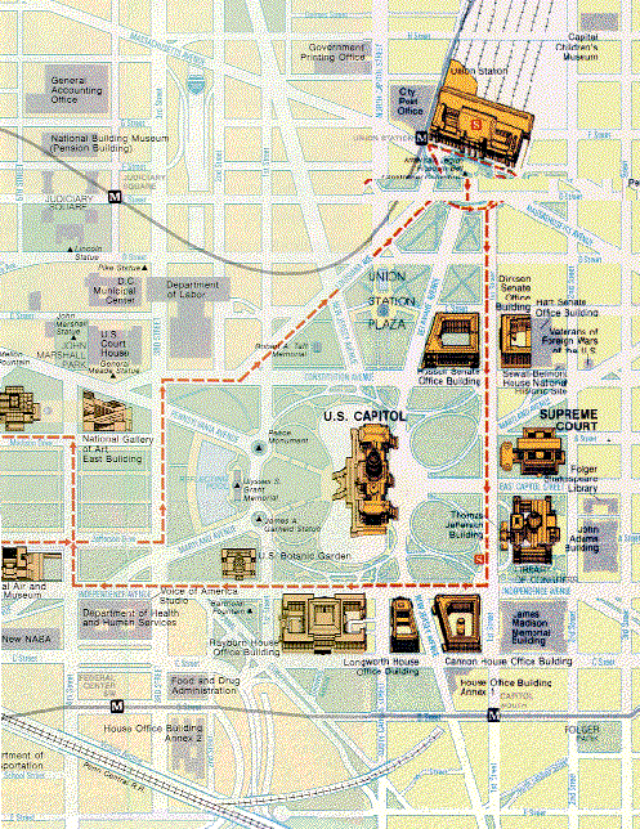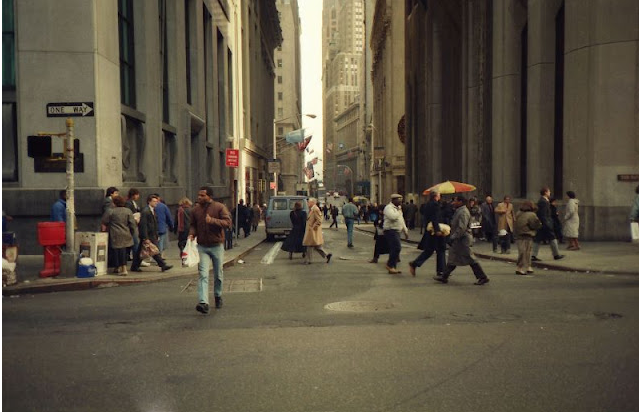The subway system of the United States Capitol in Washington, D.C. consists of three lines: two on the Senate side on the north side of the Capitol, and one on the House side on the south side of the Capitol. The House has only one line from the House side to the Rayburn House Office Building.
![]() |
| The Unites States Capitol subway system map. |
Two subway lines serve three Senate Office Buildings and have a long history. Starting in 1909, the Senate Office Buildings were serviced by an electric bus. This was replaced in 1912 by a monorail vehicle which featured a wicker coach. This monorail, I have been told, can be seen in the movie "Advise and Consent." In 1960, this monorail was replaced by trolleys, one of which remains today and runs between the Senate side and the Russell Senate Office Building. At this time, the tunnels were apparently enlarged to accommodate the new trolleys.
The trolleys installed in 1960 still run on the shortest line that runs from the Senate side to the Russell Senate Office Building. There are two trains and each runs on a dedicated track (i.e., no switches or crossovers). They are manually operated by conductors and are powered by a catenary wire. The cars themselves are open with no sides or roof. The electrical tower that leads to the catenary wires are simple aluminum duct work - very ugly. Because of the overhead lines and the manual conductor, the tracks are not separated from the adjacent pedestrian walkway by any significant barriers. These two tracks run on the north side of the tunnel.
Along the south side of the same tunnel that serves the Russell Senate Office Building, a new subway serving the remaining two buildings, Dirksen and Hart, runs parallel until the tunnel splits shortly before Russell. A pedestrian walkway runs down the middle of the tunnel until the split. The subway to Dirksen and Hart was installed in 1993, replacing the system installed in 1960. Marks along the roof of the tunnel show where the catenary wire ran.
![]() |
| Monorail subway from Capitol to Senate. The man who installed the system, 1912. |
![]() |
| Monorail subway, Capitol to Senate monorail system, 1912. |
![]() |
| O'gorman, James Aloysius. Senator from New York, 1911-1917. 3rd from right, riding monorail car, 1912. |
![]() |
| Monorail subway, Capitol to Senate. John W. Hinkel, operator of car, 1914. |
![]() |
| Senate subway R.R., circa 1915. |
![]() |
| Monorail subway, Capitol to Senate. The car, 1916. |
![]() |
| Monorail subway, Capitol to Senate. The car. Senators Swanson and Townsend as passengers, 1916. |
![]() |
| Senate Subway R.R., between 1920 and 1930. |
![]() |
| Working of U.S. Capitol monorail subway, Washington, D.C., 1937. |
![]() |
| Senate Majority Leader Alvin W. Barkley prefers to walk thru the Senate subway instead of using the tram car on his way to the opening of the special session on November 15, 1937. |
![]() |
| Senator Hattie Caraway, (left) of Arkansas, and Senator Morris Sheppard, of Texas, ride the tram car through the Senate subway on the way to attend today's Senate debate on the nomination of Senator Black as a Supreme Court Justice, August 17, 1937. |
![]() |
| Apparently no rail troubles in the Senate subway indicates Senator Burton K. Wheeler as he rides the tram car between the Senate office building and the Capitol. Senator Wheeler is Chairman of the Senate Interstate Commerce Committee which is now studying the nation's railroad problems, February 10, 1939. |
![]() |
| Senator Arthur H. Vandenberg, Republican of Michigan, using the subway from his office to the Capitol today for the opening session of the 76th Congress. January 3, 1940. |
![]() |
| U.S. Capitol monorail subway, Washington, D.C., 1940. |
(Images: Harris & Ewing/Librarian of Congress)


















